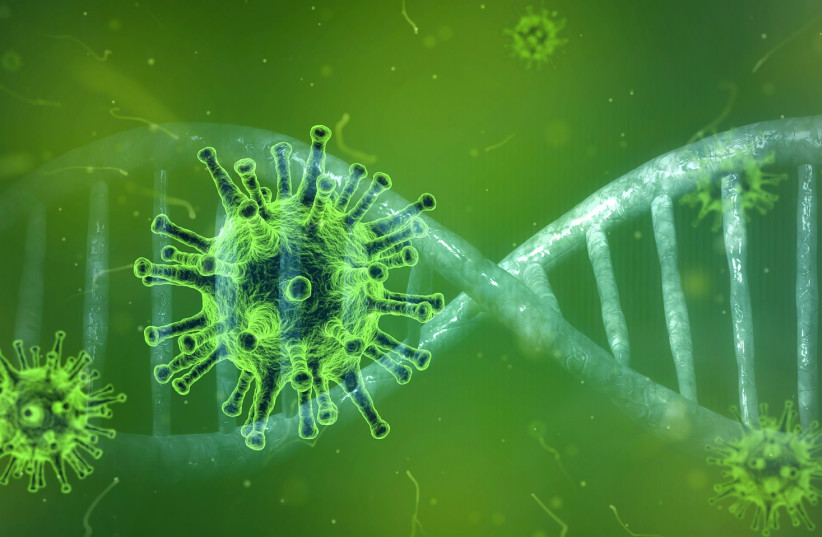Three cases of the BA.2.75 coronavirus variant were found in Israel, the Health Ministry announced on Sunday.
One of the patients had recently returned from India and the other two had returned from France.
<br>When and where did BA.2.75 start?
BA.2.75, nicknamed "Centaurus" by Twitter users (although this name has not been adopted by the World Health Organization) was first found in a sequence taken in India in early June. Since then, the variant has been spotted in Israel, Australia, Canada, Japan, Germany, New Zealand, the United Kingdom, the US, Singapore, South Korea, Denmark, France, Indonesia, Nepal and the Netherlands.
In just a matter of weeks, the variant has been detected in over 220 sequences around the world, according to data available on covSpectrum.
While it is still unclear if BA.2.75 will be able to compete with BA.5, the dominant variant in many countries at the moment, the number of mutations and its seemingly fast spread across a wide geographic area have scientists keeping an eye on it.

Cause for alarm?
Earlier this month, Dr. Shay Fleishon, with the Central Virology Laboratory at Sheba Medical Center in Tel Hashomer, called the new subvariant "alarming," stressing that while it is too soon to tell if this will be the "next dominant variant," it could imply a trend to come.
Fleishon explained in a Twitter thread that recent months have seen a trend of variants based on Omicron lineages with mutations in the S1 section of the spike protein and specifically in the part of the spike protein which the virus uses to connect to and gain entry into cells, on a level not seen in second-generation variants from other variants of concern.
Up until now, however, these second-generation variants have only been found in a few cases within one region. This is the first time a second-generation variant from Omicron has spread to multiple regions.
Scientists continuing to gather data on new variant
A new preprint study from researchers in Japan found that while the monoclonal antibodies and antibody cocktails adintrevimab, bamlanivimab, casirivimab, etesevimab, imdevimab, regdanvimab, sotrovimab, and tixagevimab were ineffective against BA.2, BA.4 and BA.5, regdanvimab, sotrovimab, and tixagevimab were effective against BA.2.75, suggesting that these last three can be used for treatment against the new variant.
Earlier this month, the Bloom Lab at the Fred Hutch research institute tweeted that the variant is "worth tracking" due to "appreciable antigenic change" compared to its parent, BA.2. The lab pointed to two mutations as key: G446S and R493Q.
G446S is a mutation that could help the virus escape from antibodies elicited by current vaccines that still are effective against BA.2.
N460K, another mutation on the BA.2.75 variant, also increases the virus's ability to attach to ACE2, according to the Bloom Lab.
On Friday, Yunlong Richard Cao shared preliminary results recently obtained regarding BA.2.75 which show that while the new variant is not quite as good at evading antibodies as BA.4 and BA.5, it does have an increased ability to attach to ACE2 than those two variants.
BA.2.75 also seems to be more able to evade immunity provided by the Delta variant, according to Cao, who added that the effectiveness of antibody drugs is no different between BA.2.75 and BA.4 and BA.5.
Cornelius Roemer, a computational biologist from the University of Basel in Switzerland, clarified that it is unclear if Cao's results concerning the new variant's ability to evade antibodies will apply to Europe and the US as well because the vaccine used in those results was the Sinovac vaccine which uses an inactivated vaccine instead of the spike mRNA that vaccines in the US and Europe use.
On Sunday, Yevgeny Timakov, a Russian specialist in infectious diseases and vaccines, told the Russian news agency TASS that BA.2.75 is at least 16% more contagious than its predecessors, but has much milder symptoms.
"It is the next generation of stealth omicron. None of those infections poses a serious threat, but they are becoming more and more transmissible. It [BA.2.75] is more contagious, by at least 16%," said Timakov.
